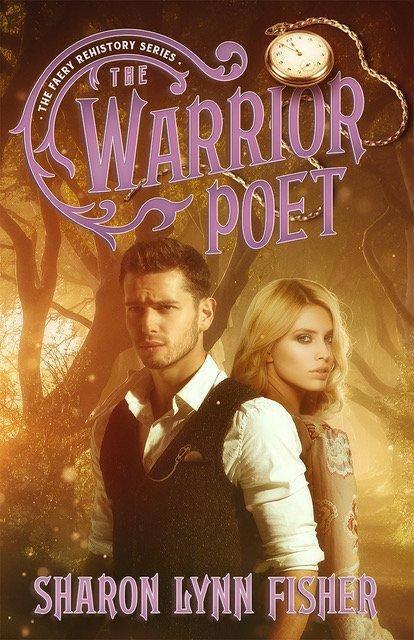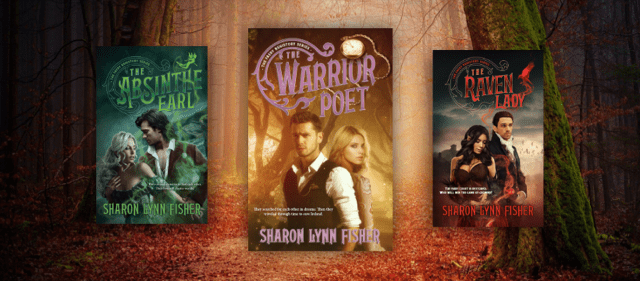
We wanted to tell you about this new tome in Sharon Lynn Fisher’s The Faery Rehistory Series, The Warrior Poet, which stars our one true love W.B. Yeats. Swoon.
We’ve always thought he was the dreamiest.
Here is the alluring synopsis:
They searched for each other in dreams. Then they traveled through time to save Ireland.
Portland book artist Neve Kelly is having weird visions—vivid daydreams of lovers on a battlefield that yank her out of reality. A couple weeks before Halloween, a confused, strangely dressed man appears in her living room. He drops a slip of paper that describes a dream much like her own before disappearing without a trace.
Will Yeats has had enough of heroics. With the peace between Ireland and its enemies restored, he plans to spend the next decade quietly writing his Irish fairy history. But suddenly he’s time-traveling again. He briefly visits the home of an intriguing stranger, who appears to be American. The next time he’s drawn there, he finds her being sucked through a ghastly hole in her ceiling.
Will saves Neve by carrying her back to 1888 Ireland, where he learns that not only is she from more than a century in the future, but from a parallel world where fairies and Tuatha De Danaan heroes are no more than myth. Their dreams of ancient lovers have brought them together … but why? Dark portents surround them—portents bearing the mark of the Morrigan’s meddling—and they soon discover it’s all part of a sinister scheme to seize the throne of Ireland. And the love story from their dreams has begun to manifest in the present moment.
Will’s friends—Irish Queen Isolde and her allies—are depending on Will and Neve to connect with the past in order to save Ireland. But can anything save them from the violent end that dreams have foreshadowed?
And an excerpt:
Will
The aroma of roasting lamb and rosemary filled the cottage, indicating my one other domestic hand was readying the evening meal. My suppers were simple, early, and generally solitary, and afterward, I spent most evenings in my study writing and nursing a glass of whiskey. I often lost track of the time and rose from my work long past the time good Christians were all abed, as my grandmother would have said.
The pleasant autumn walk had cleared my head and the excellent supper renewed my energy. Mrs. Marsh built up the fire in my study and I settled in an armchair to outline the next chapter of my memoir, which would begin my journey with Captain O’Malley on the highest point of Ben Bulben.
But it wasn’t to be. The fire was warm, the chair comfortable, and after the day’s excitement, the whiskey acted like a soporific. I soon lost the thread of my narrative.
The ticking sound in my head woke me. I sat up, blinking in the low light. My eyes fell on the last line I’d scribbled on my notebook.
The past will swallow her.
The ticking grew louder, and I trained my focus on the room—the fireplace, the desk, the typewriter—trying to hold onto my place in time, if only for a moment. But a shadowy veil fell over everything and I felt the floor go out from under me. My stomach dropped too, and then I was falling in starry darkness.
Pain shot through one knee as I landed on a hard floor. I closed my eyes against the spinning sensation, trying not to retch.
A violent disturbance—and horrible stench—made me open my eyes. There was a monstrous hole in the center of the room’s ceiling, like the gaping wound of some beast. It was sucking the air out of the room. I saw the American woman—she was trying to anchor herself on the back of a sofa as loose objects around her were swept up and into the hole.
She’s going to be next.
“Lady!” I shouted, but the eldritch roar of the thing drowned out all other sound. She hadn’t seen or heard me.
I launched to my feet, ignoring the pain in my bruised knee. The hot, sucking wind was whipping me too, and it got much stronger as I drew nearer the opening. The moment before I reached her, she let go of the sofa to block something that had flown at her face—a book. She grabbed it as her body lifted toward the ceiling.
Lunging, I caught her around the waist—but the force of the suction pulled me up with her.
For the love of God, let us get away from here!
The wind and noise cut off suddenly—the livid tissue overhead was replaced by the relative tranquility of the Gap. I tightened my arms around her, afraid of what would happen to her if we became separated—it was possible to drift forever in the Gap.
In her panic and confusion, she fought me, and I muttered a feeble, “I’m sorry.”
Our impact with the floor of my study broke us apart.
The lady rolled over and looked at me, her gray-green eyes wide with shock. She wrapped bare arms around bare legs, her whole body trembling. She was like a lost, half-wild creature—the state of her wrung my heart. But I dared not speak yet, even to comfort her, for fear of making things worse.
Her gaze moved around my study and she shook her head. “Not happening,” she said, despair in her voice.
She closed her eyes tightly, and the color of her complexion faded from sun-kissed fair to verging on pale green. I scrambled for the waste bin next to my desk and slid it toward her.
I watched in sympathy as she braced her hands against the bin—knuckles white—and emptied the contents of her stomach.
Then she wiped her mouth with the back of her hand and said, “I don’t think I imagined that.”
“No, lady,” I assured her. “You did not.”
Here are all three books of the series, hanging out in the deep wood:

And then below we ask Sharon some illuminating questions:
What is a faery rehistory?
I chose this title for the trilogy because the books are set in an alternate Victorian-era Ireland, and also because I created my own story about why the fairies disappeared from Ireland and how they returned. I suppose it’s a little obscure, as titles go, but when it popped into my head I instantly loved it!
Can you tell us about this series and what inspired it?
I had a fairy best friend when I was an adolescent, and my mother gave me Faeries by Brian Froud and Alan Lee around the same time. I went on to collect numerous reference books on fairies and Celtic lore, knowing that one day I’d write about them. About five years ago, I wrote a short story about a reincarnated Merlin and Vivien set on Isle of Skye in the Victorian era, and I loved writing that so much that I decided it was time to create my fairy saga. Then while I was researching, I discovered the connection between absinthe and fairies. The first scene in book one, The Absinthe Earl, came to me: a folklore scholar researching absinthe and fairies stops for tea in an Irish pub, where she meets a charming but mysterious Irish earl who turns out to have a connection to the Tuatha De Danaan.
What about The Warrior Poet? How did Irish poet Yeats become star of this book?
I was really inspired by W.B. Yeats’ writings about Irish mythology, so I ended up giving him (or rather a fictionalized version of him) a cameo in The Absinthe Earl. He had a larger role in book two, The Raven Lady, where he joined the king and queen of fairies in a battle to save Ireland—and in the process learned to talk to trees and accidentally became a time traveler. I loved the idea of bringing a modern character into book three (Neve, from Portland, Oregon), and REALLY loved the idea of Yeats as a warrior poet, so those things all came together nicely.
Is this book standalone? How does it connect to the other two books?
The Warrior Poet takes place five years after book two, The Raven Lady. An old enemy has returned, and appears to be allied with the Morrigan against Ireland’s Queen Isolde. The Warrior Poet can be standalone, definitely, and the first reviews the book received were written by readers who’d only read that book. But I do think it’s a richer experience if you’ve read the others—characters from books one and two come back into book three.
Do you have a special love for Yeats and/or Ireland?
I do feel a bit of a kinship with Yeats and his love of his country—its mythology, its mist and rolling green hills. I loved Ireland even before I visited it—I think the German word fernweh gets at that. (I feel that way about Iceland too, which comes into play in books two and three.) On one trip, I spent two weeks in the west of Ireland, where Yeats country is, along with some incredible magical landscapes.
How did your own trips to Ireland fuel the narrative?
The pubs in Dublin, Trinity College Library, the National Museum of Ireland with its bog man, the ancient passage tomb at Newgrange, the staggering beauty of Connacht…all of it found its place in the Faery Rehistory trilogy.
What do you hope your reader takes from your faery rehistories?
I hope more than anything they feel they’ve been swept away on a magical journey. That they feel immersed in a world of wonder. Like I felt when I read Tolkien.
And then, in your everyday life, how do you stay enchanted?
Over the course of the pandemic, this became more important to me than ever before. I rediscovered magic during those long days of isolation. I developed my own spiritual (witchy) practice, working with candles, herbs, stones, shells…pretty much whatever comes to hand. I spend as much time as I can in the woods, seeing things in a way I haven’t since I was a child. I observe the changing seasons and the phases of the moon. I try to be more present.
Isn’t that lovely? You can see more from Sharon at https://www.sharonlynnfisher.com/

































